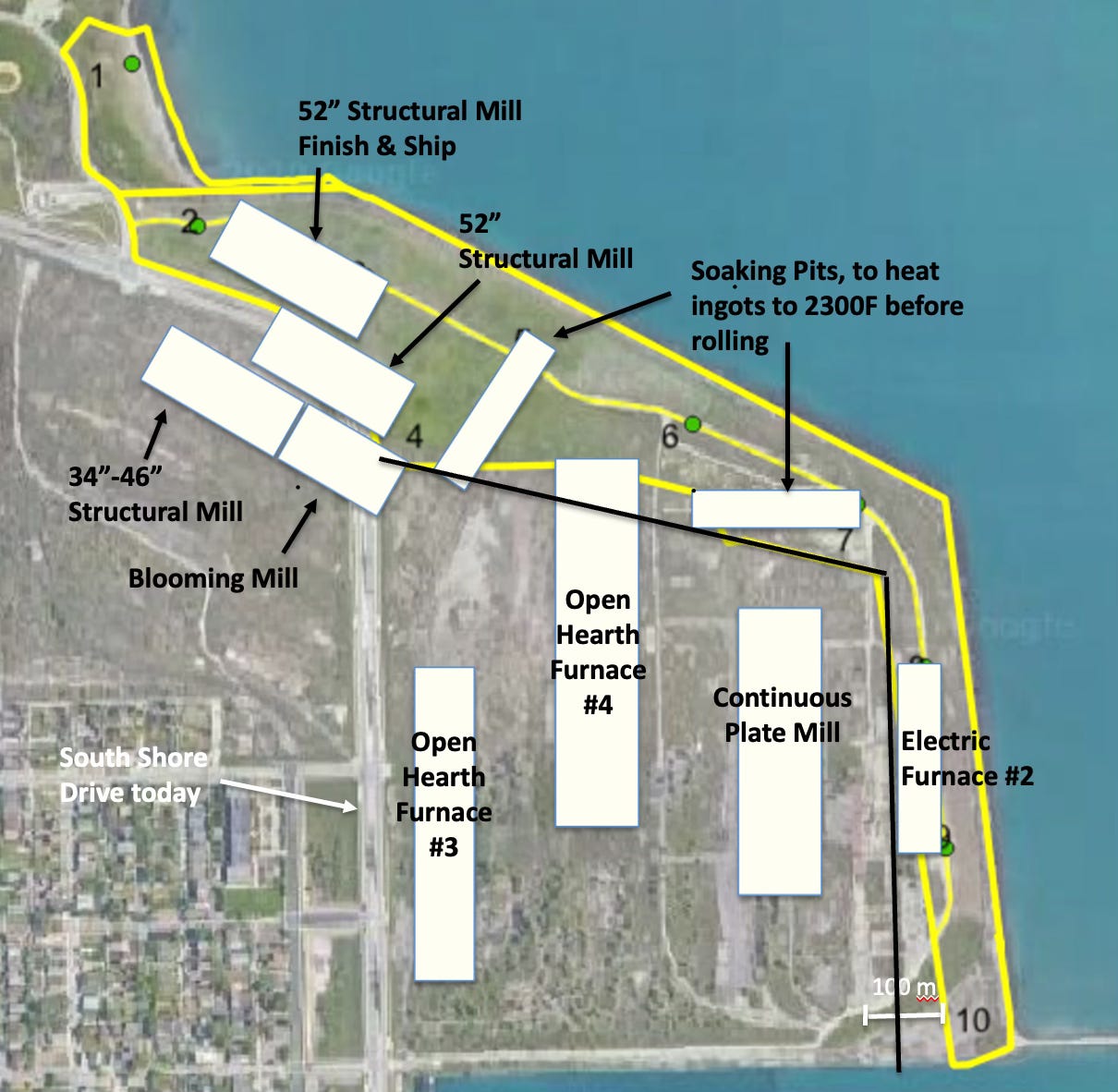On the 560-acre site that was once US Steel South Works, a chain-link fence is the line of demarcation between the eighty percent of the land still owned by US Steel and the narrow strip of land along Lake Michigan that is Park 566. The fence cuts a straight line running east-southeast from the northwest corner of Park 566 until it makes a soft right turn and continues due south to the ore slip at the far end of the park.

I’ve nothing against this fence. It’s just doing its job, telling us where we can and can’t go. It slices straight through the sprawling steel mill that once stood here, with no regard for what lies below. But we know. So as we walk the fence line, we can take a virtual tour of the old plant. At the fence’s northwest starting point almost directly beneath us are the Beam Mill Soaking Pits, where massive 7-ton steel ingots were placed on end in below-ground chambers and brought up to temperature for rolling into I-beams and other structural steel.
Wading on through shoulder-high, tick-infested grasses, we and the fence cut right across the north tip of Open Hearth Furnace No. 4. Here pig iron and scrap steel were melted, decarburized and poured into ingots for eventual rolling.
Past the Open Hearth Furnace No. 4, and just before we turn right to head south, we pass another Soaking Pit, on our left. When we turn right to follow the fence due south, we find ourselves walking alongside the 96” Continuous Plate Mill on our right, which continues almost to the ore slip. On our left, between us and the lake, is Electric Furnace Plant No. 2.
The fence—and our walk—ends when we reach the ore slip, where ore tankers unloaded their cargo of iron ore from the mines of northern Minnesota.
Fifty years ago when this steel mill was in operation, this fence would have placed us in grave danger if we had dared to follow its straight line through the plant. But now, with all the buildings razed, and their cement footings covered in most places with a meter of fill dirt, the only danger to our persons is sunburn and tick bites.
Some might consider the chain link fence an eyesore. Or an obstruction. I consider it a cause for reflection. It’s a straight line through the twisted history of this amazing site.
In the past seven and a half years, I’ve walked this fence 1,255 times. And as I walked, I’ve thought often about those things the fence can never know, the things that lie beneath, the steel mill where for a century men and women labored to transform ore from the hills of Minnesota into steel that built our cities. This fence cuts straight across that history.
I think of the marshy shore that was here long before the steel mill, where Potawatomi tended their beaver and muskrat traps, and French traders came in canoes to barter for the furs. That marshland of 300 years ago is directly below me, covered in 30 feet of slag from the steel mill. The straight line traced by the fence cuts through that marshland as well.
A straight line is the shortest distance between two points, but thoughts and memories seldom travel in straight lines. As my body follows the arrow-straight fence, my mind is meandering—1833, 12,000 BCE, 1901, yesterday, 1972. It’s a wondrous thing, when time is compressed in one location. I am grateful to the fence for offering me a straight line along which I can get lost in the maze of the past.
OK, now that you think I’m crazy, with these Interstellar-like thoughts, let me tell you why I started walking this fence in the first place. Seven and a half years ago, before I had learned anything about this land’s history, it was only birds I was looking for. And it didn’t take me long to realize that this fence was a great place to find birds.
When I walked the open areas of the park, any birds I flushed would usually fly off before I had any chance of photographing them or identifying them. But when I walked the fence, birds that flushed from the grasses would often land on the fence, however briefly, as if to check me out. Sometimes they were nice enough to sit there long enough for me to ID them and to snap a few photos. The fence was a virtual bird magnet, and the number of species that presented themselves there grew and grew—mainly passerines, but also raptors, corvids, shorebirds, and even a Wild Turkey.
Still today, to be honest, I walk the fence more for the birds, than for the history. Still today, I continue to be thrilled by chance encounters along that fence. Sometimes those encounters are with living, singing birds; sometimes they are with deeply buried memories from the history buried beneath the fence.
I am going to begin showing you some of the birds I have met on the fence. Galvanized steel is not the most flattering setting for such beautiful creatures. But consider that whenever a bird perches on the fence at Park 566—be it a year-round resident, or a seasonal migrant—it grounds itself through that fence in the amazing history of this park and becomes itself part of that history.
Enjoy these birds as they make use of the steel perch provided for them by Park 566.
The first bird On the Fence at Park 566 is a Spotted Sandpiper that I saw this past Saturday. It apparently had a nest nearby and was patrolling the ramparts against this human intruder.




